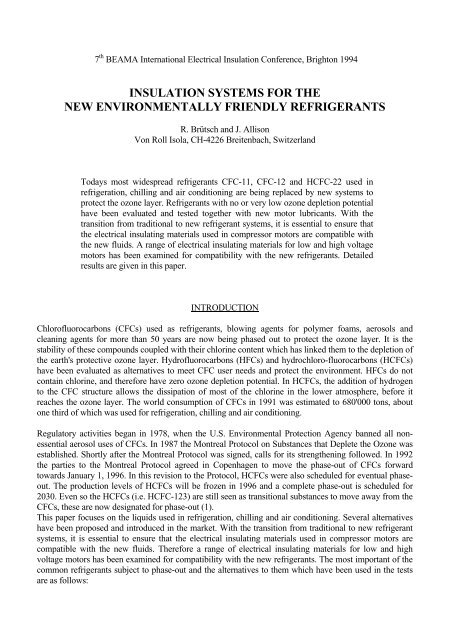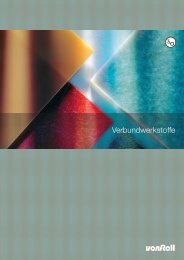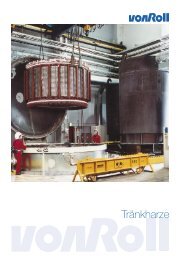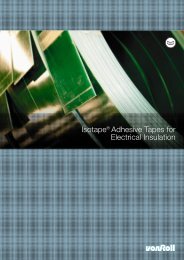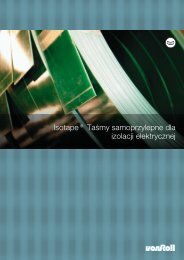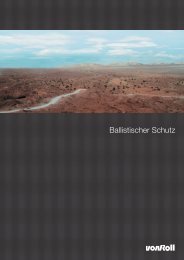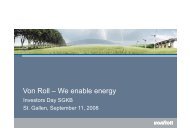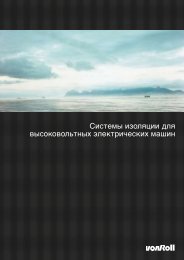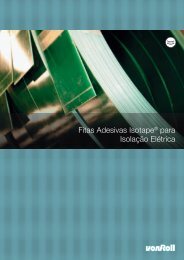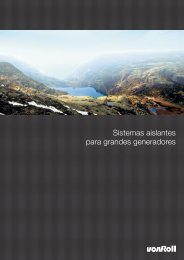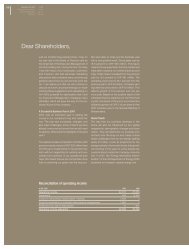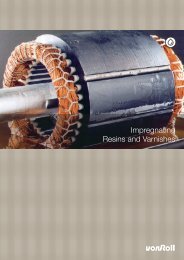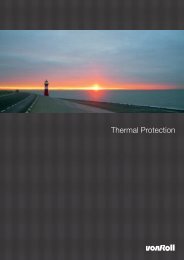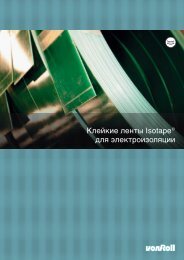Englisch (PDF-Datei / 0,2 MB) - Von Roll
Englisch (PDF-Datei / 0,2 MB) - Von Roll
Englisch (PDF-Datei / 0,2 MB) - Von Roll
Create successful ePaper yourself
Turn your PDF publications into a flip-book with our unique Google optimized e-Paper software.
New refrigerant: Replacement for: Applications:HCFC-123 CFC-11 Centrifugal chillersHFC-134a CFC-12 Domestic, automotive and commercialrefrigeration systems, medium temperaturefood cases and chillers, air conditioningBlend of HFC-32, HCFC-22 Low and medium temperature applications,HFC-125 and HFC-134adomestic and commercial refrigeration,air conditioningBlend of HFC-32, CFC-502 Commercial refrigeration (supermarkets,HFC-125 and HFC-134aice machines, transport)In nearly all the cases where HFCs are used as replacements, the lubricant used in the system is differentthan used with CFCs or HCFCs. The new synthetic lubricants which replace the mineral oils traditionallyused with CFCs are from two main classes: polyalkylene glycol and polyol ester. A broad range of thenew lubricants was included in the examinations together with the new refrigerants.EXPERIMENTALVarious electrical insulating materials manufactured by <strong>Von</strong> <strong>Roll</strong> Isola were selected for the test, see table1. Compatibility of the materials was assessed by exposure to either refrigerant or refrigerant-lubricantmixtures at elevated temperatures and pressures. The testing procedure complies to the ASHRAEstandard (ANSI/ASHRAE 97-1983, Sealed glass tube method to test the chemical stability of material foruse within refrigerant systems). The materials were placed in an autoclave and measured weights ofrefrigerant - and lubricant if required - were added. The autoclave was then heated to 130 °C (90 °C in thecase of HCFC-123) for a period of 14 days at autogenous pressure (approximately 600 psig). Oncompletion, the autoclave was allowed to cool down to ambient temperature. The samples were removedand visual changes (appearance of bubbles or blisters, changes in colour etc.) as well as changes in weightand volume were determined within a few minutes. Where appropriate, changes in other properties suchas hardness, tensile strength, flexural strength and bond strength were measured. Weight changedetermined is the sum of any weight loss due to material dissolution or extraction and any absorption ofrefrigerant by the sample.The compatibility of winding wire lubricants with HFC-134a / ester lubricant systems was examined in aseparate test. Solubility of various winding wire lubricants was tested in the ester lubricants at 0.3 % byweight and in 15 % ester / 85 % HFC-134a at 0.05 % by weight in the temperature range of -40 °C to +80°C.The tests with HFC-134a and the HCFC-22 and CFC-502 replacement refrigerants were done by ICIKlea, Widnes, Cheshire, UK and those with HCFC-123 by DuPont, Wilmington, Delaware, USA.
RESULTS AND DISCUSSIONThe performance of the electrical insulating materials in the new refrigerants and refrigerant-lubricantmixtures is compiled in table 2.HFC-134a / ester lubricant systems, HCFC-22 and CFC-502 replacement refrigerants: All of the materialsselected for low and high voltage motors performed in general as well as, or better in the new refrigerantsand refrigerant / lubricant mixtures than they did in CFC-12, HCFC-22 and their mixtures with mineraloil. The visual inspection of the insulating materials showed no appearance of bubbles or blisters in anycase (2, 3).HFC-134a is now generally accepted as being the most appropriate ozone-benign refrige-rant to replaceCFC-12 in most application areas. Replacement of CFC-502 and HCFC-22 is more complicated by thefact, that unlike the CFC-12 / HFC-134a situation, at present there is no single refrigerant moleculecapable of closely matching the physical and thermodynamic properties of the threatened materials. Forlack of a single component solution, refrigerant blends are proposed.The traditional mineral oil lubricants used with CFC-12, HCFC-22 and CFC-502 are not compatible withHFCs. HFCs require the use of polyalkyleneglycols (PAGs) and polyolesters as lubricants. Because oftheir relatively high water affinity the PAG lubricants have been essentially displaced by the polyolestersin these applications. Of great importance is also the choice of the suitable winding wire lubricant.Conventional paraffinic motor winding lubricants have been found to block capillary tubes in domesticfridge/freezer systems when used with polyolester lubricants. Selection of winding lubricants for use insuch systems requires careful consideration.HCFC-123: Current oils used with CFC-11 are fully soluble in HCFC-123 over the range of expectedoperating conditions. This means that mineral oil will generally be used as lubricant together with HCFC-123. The same hydrogen atom which makes HCFC-123 desirable from an environmental standpointmakes it a stronger solvent than CFC-11. Because of this, HCFC-123 is more aggressive towardspolymers, which was confirmed by the test results. Several electrical insulating materials which arecompatible with other refrigerants fail in HCFC-123. Careful selection of materials is necessary whendesigning equipments using HCFC-123.REFERENCES1. Dekleva T.W. and Yost R.W., 1993, Responding to the CFC Challenge, Proc. Electrical/ElectronicsInsulation Conference, Chicago, 4952. Brütsch R., Allison J. and Tompsett G., 1992, Insulation Systems and the New Refrigerants, Proc.Int. Coil Winding Assoc., Cincinnati, 2193. Corr S., Dekleva T.W., Dowdle P., Tompsett G., Allison J. and Brütsch R., 1993, Compatibility ofNon-Metallic Motor Components with R-22 and R-502 Replacement Refrigerants, Proc.Electrical/Electronics Insulation Conference, Chicago, 507
TABLE 1: Details of Materials, Structure and ApplicationNo. Material Name Composition Application1 Myoflex PVS Composite of PET between two polyester felts impregnated with resin Slot lining insulation (class F)2 Myoflex N Composite of PET between two polyamide papers impregnated with resin Slot lining insulation (class F)3 Vetroflex 253.13 Glass fibre tape impregnated with epoxy resin Field coil and slot lining insulation (class F)4 Vetroflex 253.10 Glass fibre tape impregnated with polyurethane resin Field coil and slot lining insulation (class F)5 Samicatherm 366.28 Composite of mica paper and glass fabric impregnated with epoxy resin Insulation for high voltage motors (class H)6 Epoflex 215.01 Polyester fleece tape impregnated with pigments and flexible epoxy resin Insulation at coil ends (class F)7 Filosam 326.52 - 11 Composite of mica, glass threads and polyester film impregnated with acrylic resin Flexible insulation for h.v. motors (class F)8 Filosam 326.52 - 30 Composite of mica, glass threads and polyester film impregnated with epoxy resin Flexible insulation for h.v. motors (class F)9 Resin 3308 + 366.58 Composite of mica/glass fabric impregnated with polyesterimide resin Insulation for high voltage motors (class H)10 Isomica 326.04 Mica - glass fabric - polyester film impregnated with polybutadiene resin Conductor and ground insulation (class F)11 Isomica 326.12 Mica - glass fabric - polycarbonate film impregnated with polybutadiene resin Conductor and ground insulation (class F)12 Resin 3316 Unsaturated polyesterimide resin containing styrene as thinner Motor winding resin for rotors and stators (class F)13 Resin 3305 Solventless unsaturated polyesterimide resin Motor winding resin, final dip (class F)14 Resin 3405 Modified epoxy resin with little solvent Motor winding resin for rotors and stators (class F)15 Resin 3360 Modified unsaturated polyesterimide resin without styrene Motor winding resin for rotors and stators (class F)16 Exar - 500 Modified crosslinked polyolefin Motor lead wire (class F)17 2MN - 180 Diacetate fibres, PET film and polyamide paper with polyester/polyurethane coat Motor lead wire (class H)18 2PM-700 Polyester yarn and tape Motor lead wire (class F)19 Samicaflex Micapaper and glass fabric impregnated with a silicone binder Armature winding insulation (class C)20 Siwo - Kul Silicone rubber and synthetic yarn braid impregnated with polyurethane resin Cables for h.v. motors (class H)21 RT8 Tying Tape Stabilised rayon impregnated with resin Tape for lacing and binding coils22 Siligaine Sleeve Impregnated polyester braid Compressor cable insulation (class B)23 Polyglas H200 Glass yarns impregnated with polyester resin Banding tape (class C)24 Conductive Tape 215.55 Polyester non - woven fleece impregnated with carbon particles/epoxy resin Control of corona discharges in h.v. motors (class F)25 Semiconductive Tape 217.31 Polyester fabric impregnated with silicone carbide/epoxy resin With conductive tape, dissipates corona charge (class F)26 G11 Laminate Woven glass cloth impregnated with epoxy resin Dielectric APPS with high mechanical stresses27 GP03 Laminate Woven glass cloth impregnated with polyester resin Terminal boards and switch gear28 Thermex 180 PZ/2 THEIC modified Polyesterimide Enamelled motor winding wire (class H)29 Thermex 200 PZ/2 Polyesterimide with polyamideimide overcoat Enamelled motor winding wire (class C)30 Thermex 305 Modified polyesterimide Enamelled motor winding wire (class H)31 Thermex 306 Modified polyesterimide with polyamideimide overcoat Enamelled motor winding wire (class C)32 Thermibond 158 Modified polyesterimide, self bonding Enamelled motor winding wire (class H)33 Thermibond 164 Modified polyesterimide, self bonding Enamelled motor winding wire (class C)34 Varnish 2004 HFP Hard phenolic resin Motor winding varnish, final dip (class B)35 Varnish 2005 HFP Modified alkyd polyester resin Motor winding varnish, final dip (class F)36 Varnish 2053 HFP Modified polyesterimide resin Motor winding varnish, final dip (class H)37 Daglas Glass filament fused with synthetic yarn Used with enamelled wire (class F)Materials supplied by <strong>Von</strong> <strong>Roll</strong> Isola
TABLE 2: Compatibility of Electrical Insulating Materials for Low and High VoltageApplications with the New Refrigerant and Refrigerant / Lubricant SystemsNo. MATERIAL CONDITION a b c d e f g h i j k l m n o p1 Myoflex PVS X X X X X OK OK OK OK OK OK OK OK OK OK OK2 Myoflex N OK OK OK OK OK OK OK OK OK OK OK OK OK OK OK X3 Vetroflex 253.13 OK OK OK OK OK OK OK OK OK OK OK - - - - -4 Vetroflex 253.10 OK OK OK OK OK OK OK OK OK OK OK - - - - -5 Samicatherm 366.28 OK OK OK OK OK OK OK OK OK OK OK - - - - OK6 Epoflex 215.01 X OK OK X X X X OK OK X OK - - - - -7 Filosam 326.52 - 11 OK OK OK X X OK OK OK OK OK OK - - - - -8 Filosam 326.52 - 30 X X OK X OK OK X X X X X - - - - X9 Resin 3308 + 366.58 OK OK OK OK OK OK OK OK OK OK OK - - - - -10 Isomica 326.04 OK OK OK X OK OK OK OK OK OK OK - - - - -11 Isomica 326.12 X X OK X X X X OK X OK X - - - - -12 Resin 3316 - - - - - - - - - - - OK OK OK OK X13 Resin 3305 - - - - - - - - - - - OK OK OK OK OK14 Resin 3405 OK OK OK OK OK X OK OK OK OK X - - - - -15 Resin 3360 OK OK OK OK OK OK OK OK OK OK OK - - - - -16 Exar - 500 OK OK OK X OK OK OK OK OK OK OK - - - - -17 2MN - 180 X X X X X X X X X X X OK OK OK OK X18 2PM - 700 - - - - - - - - - - - - - - - OK19 Samicaflex OK OK OK OK OK OK OK OK OK OK OK - - - - OK20 Siwo - Kul X X X X X X X X X X X - - - - X21 RT8 Tying Tape X X X X X X X X X X X OK OK OK OK X22 Siligaine Sleeve X X X X X X X X X X X - - - - -23 Polyglas H 200 - - - - - - - - - - - - - - - OK24 Conductive Tape 215.55 OK OK OK OK OK OK OK OK OK OK OK - - - - OK25 Semiconductive Tape 217.31 OK OK OK OK OK OK OK OK OK OK OK OK OK OK OK X27 GP03 Laminate OK OK OK OK OK OK OK OK OK OK OK - - - - -28 Thermex 180 PZ/2 OK OK OK OK OK OK OK OK OK OK OK OK OK OK OK -29 Thermex 200 PZ/2 OK OK OK OK OK OK OK OK OK OK OK OK OK OK OK -30 Thermex 305 OK OK OK OK OK OK OK OK OK OK OK - - - - X31 Thermex 306 OK OK OK OK OK OK OK OK OK OK OK - - - - OK32 Thermibond 158 OK OK OK OK OK OK OK OK OK OK OK - - - - OK33 Thermibond 164 OK OK OK OK OK OK OK OK OK OK OK - - - - OK34 Varnish 2004 HFP OK OK OK OK OK OK OK OK OK OK OK OK OK OK OK OK35 Varnish 2005 HFP OK OK OK OK OK OK OK OK OK OK OK OK OK OK OK X36 Varnish 2053 HFP OK OK OK OK OK OK OK OK OK OK OK OK OK OK OK X37 Daglas OK OK OK OK OK OK OK OK OK OK OK - - - - OKKey:a: R 22 e: R 22 / SUNISO 3 GS i: R 32 / R 134a / EMKARATE RL 32S m: R 134a / EMKARATE RL 32Sb: R 32 f: R 32 / EMKARATE RL 68S j: R 22 / EMKARATE RL 68S n: R 134a / EMKARATE RL 68Sc: R 134a g: R 32 / EMKARATE RL 32S k: R 22 / EMKARATE RL 32S o: R 12 / SHELL CLAVUS 32d: R 32 / R 134a (30 : 70) h: R 32 / R 134a / EMKARATE RL 68S l: R 134a / EMKARATE RL 15S p: R 123OK: Visually no changeX: Change occurred Electrical insulating materials supplied by <strong>Von</strong> <strong>Roll</strong> Isola-: Not tested EMKARATE lubricants supplied by ICI


